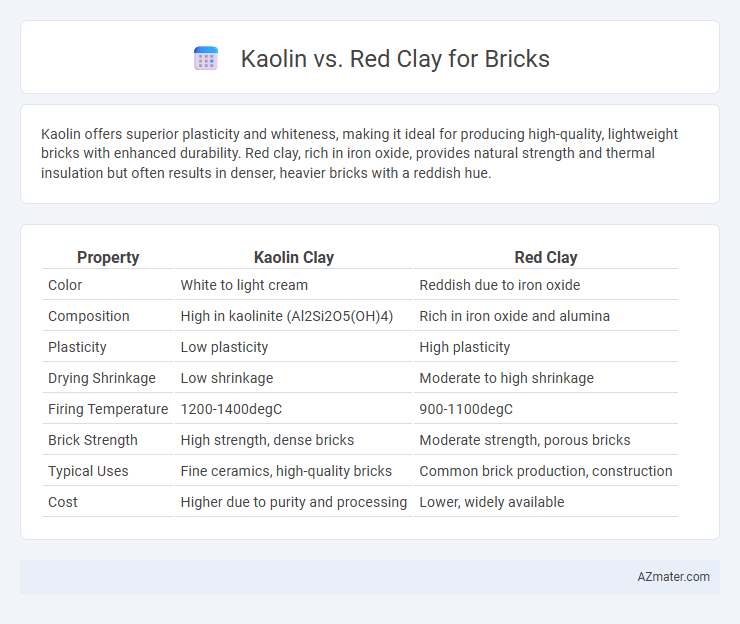Kaolin offers superior plasticity and whiteness, making it ideal for producing high-quality, lightweight bricks with enhanced durability. Red clay, rich in iron oxide, provides natural strength and thermal insulation but often results in denser, heavier bricks with a reddish hue.
Table of Comparison
| Property | Kaolin Clay | Red Clay |
|---|---|---|
| Color | White to light cream | Reddish due to iron oxide |
| Composition | High in kaolinite (Al2Si2O5(OH)4) | Rich in iron oxide and alumina |
| Plasticity | Low plasticity | High plasticity |
| Drying Shrinkage | Low shrinkage | Moderate to high shrinkage |
| Firing Temperature | 1200-1400degC | 900-1100degC |
| Brick Strength | High strength, dense bricks | Moderate strength, porous bricks |
| Typical Uses | Fine ceramics, high-quality bricks | Common brick production, construction |
| Cost | Higher due to purity and processing | Lower, widely available |
Introduction to Kaolin and Red Clay in Brickmaking
Kaolin and red clay are essential raw materials in brickmaking, each offering distinct properties that influence brick quality and performance. Kaolin, a white, fine-grained clay mineral rich in kaolinite, provides excellent plasticity and firing strength, resulting in lightweight, durable bricks with a smooth texture. Red clay contains higher iron oxide content, imparting a characteristic red color and increased hardness upon firing, making it ideal for traditional, robust brick production.
Chemical Composition Differences
Kaolin, primarily composed of kaolinite (Al2Si2O5(OH)4), contains high levels of alumina and silica with low iron oxide content, resulting in lighter-colored bricks. Red clay features higher amounts of iron oxide (Fe2O3), which imparts a reddish hue to bricks and affects their firing temperature and strength. The chemical composition differences influence the bricks' color, durability, and thermal properties, with kaolin bricks being more chemically stable and red clay bricks exhibiting greater plasticity during molding.
Physical Properties: Texture and Color
Kaolin bricks exhibit a smooth, fine texture with a pale white to light gray color due to their high alumina content, making them ideal for precision applications and aesthetic finishes. Red clay bricks have a coarse, gritty texture with a characteristic reddish-brown hue resulting from iron oxide, which contributes to their strength and durability in construction. The distinct physical properties of kaolin and red clay influence brick manufacturing processes, thermal resistance, and visual appeal in masonry projects.
Performance in Firing and Durability
Kaolin bricks exhibit superior firing performance due to their high alumina content, resulting in lower shrinkage and better resistance to thermal shock compared to red clay bricks. Red clay bricks, rich in iron oxide, tend to fire at lower temperatures but may show increased porosity, affecting long-term durability under harsh weather conditions. Kaolin bricks generally achieve higher compressive strength and lower water absorption, making them more durable for structural applications.
Workability and Molding Characteristics
Kaolin exhibits high plasticity and fine particle size, enhancing workability and allowing for precise molding with smooth surfaces in brick production. Red clay contains more coarse particles and iron oxides, which can reduce plasticity but improve drying strength, making molding slightly less flexible yet durable. Optimal brick quality often involves balancing Kaolin's superior workability with Red clay's mechanical stability during shaping and drying stages.
Cost and Availability in Construction
Kaolin clay typically costs more than red clay due to its higher purity and specialized processing requirements, impacting overall brick production expenses. Red clay is more widely available and abundant in many regions, resulting in lower material costs and easier sourcing for construction projects. Cost efficiency and accessibility make red clay the preferred choice for large-scale brick manufacturing compared to the relatively expensive and less common kaolin.
Environmental Impact Comparison
Kaolin clay bricks typically have a lower environmental impact due to their higher plasticity and firing efficiency, resulting in reduced energy consumption and lower carbon emissions during production compared to red clay bricks. Red clay bricks often require higher firing temperatures and longer kiln times, increasing fuel usage and greenhouse gas output. The mining process for red clay can also cause more extensive soil degradation and habitat disruption relative to the more refined extraction of kaolin.
Suitability for Different Brick Types
Kaolin is ideal for producing white and light-colored bricks due to its high purity and low iron content, making it suitable for decorative and structural bricks requiring smooth textures. Red clay, rich in iron oxide, is perfect for traditional red bricks and offers excellent strength and durability, commonly used in load-bearing walls and paving. The choice between Kaolin and red clay depends on the desired brick color, strength requirements, and application in construction projects.
Aesthetic Considerations in Finished Bricks
Kaolin bricks exhibit a smooth, light-colored, and uniform surface, making them ideal for architectural designs emphasizing clean, modern aesthetics with soft pastels. Red clay bricks, rich in iron oxide, produce deep, vibrant red hues and rustic textures that enhance traditional, warm, and earthy appearances in masonry. The choice between kaolin and red clay significantly affects the visual character and style of the finished brickwork, influencing design decisions in both residential and commercial projects.
Choosing the Optimal Clay for Your Project
Kaolin and red clay offer distinct properties for brick manufacturing, with kaolin providing a lighter color and smoother texture due to its high purity and low iron content, making it ideal for decorative or specialty bricks. Red clay, rich in iron oxide, delivers a characteristic red hue and higher plasticity, which enhances workability and strength, suitable for structural bricks requiring durability. Selecting the optimal clay depends on project requirements, such as aesthetic preferences, structural demands, and firing temperatures, ensuring the final brick meets performance and design specifications.

Infographic: Kaolin vs Red clay for Brick
 azmater.com
azmater.com